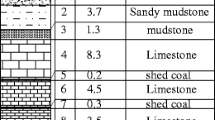Abstract
Based on the field measurement of the end resistance of the support during the initial weighting of the basic roof and the macroscopic mine pressure behavior during the weighting period of 101, 22,211, 103 and 301 fully mechanized caving face in Changchun **ng Coal Mine, the mine pressure law of the working face is summarized and compared. Furthermore, the relationship between the working face length, the working resistance of the support (the weighting strength) and the macroscopic mine pressure behavior is obtained. In the range of face length 126–230 m, with the increase of face length, the end-of-cycle resistance of the support gradually increases, the dynamic load coefficient of the support gradually increases, and the strata behavior of the working face changes from strong to very strong. When the face length is short (126–140.5 m), the hanging roof area is too large to cause hurricanes when the working face is pressed, which threatens and damages the personal safety and equipment of the working face staff. Based on the above research, the problem of optimizing the surface length is proposed, and the surface length is determined to be within the range of 140–230 m.










Similar content being viewed by others
References
Alehossein H, Poulsen BA (2010) Stress analysis of longwall top coal caving. Int J Rock Mech Min Sci 47(1):30–41
Basarir H, Oge IF, Aydin O (2015) Prediction of the stresses around main and tail gates during top coal caving by 3D numerical analysis. Int J Rock Mech Min Sci 76:88–97
Brady BHG, Brown ET (2004) Rock mechanics for underground mining, 3rd edn. Kluwer Academic Publishers, London
Hebblewhite B, Simonis A, Cai Y (2002) Technology and feasibility of potential underground thick seam mining methods. UNSW Mining Research Centre, Berlin
Hebblewhite BK (2013) International practice in high performance underground thick coal seam extraction and related ground control challenges. In: Proceedings of the 32nd international conference on ground control in mining. Morgantown (WV): West Virginia University; pp. 38–44
Hoek E, Kaiser PK, Bawden WF (1995) Support of underground excavations in hard rock. A.A. Balkema, Rotterdam
Huang BX, Liu CY (2006) Experimental research on drawing top coal with loose medium model under dead unconsolidated sandstone roof. J Min Saf Eng 35(3):351–355
Humphries P, Poulsen B, Ren T (2006) Longwall top coal caving application assessment in Australia. Commonwealth Scientific and Industrial Research Organisation, Brisbane
Huo Y, Song X, Sun Z, Wang Z, Li H (2020) Evolution of mining-induced stress in fully mechanized top-coal caving under high horizontal stress. Energy Sci Eng 8:2203–2215. https://doi.org/10.1002/ese3.658
Khanal M, Adhikary D, Balusu R (2014) Prefeasibility study-geotechnical studies for introducing longwall top coal caving in Indian mines. J Min Sci 50(4):719–732
Mohammad N, Reddish DJ, Stace LR (1997) The relation between in situ and laboratory rock properties used in numerical modelling. Int J Rock Mech Min Sci 34(2):289–297
Vakili A, Hebblewhite BK (2010) A new cavability assessment criterion for longwall top coal caving. Int J Rock Mech Min Sci 47(8):1317–1329
Wang J (2014a) Development and prospect on fully mechanized mining in Chinese coal mines. Int J Coal Sci Technol 1(3):253–260
Wang J (2014b) Caving mechanisms of loose top coal in longwall top coal caving mining method. Int J Rock Mech Min Sci 25:160–170
Wang J, Yu B, Kang H, Wang G, Mao D, Liang Y et al (2015) Key technologies and equipment for a fully mechanized top-coal caving operation with a large mining height at ultra-thick coal seams. Int J Coal Sci Technol 2(2):97–161
Wang J, Zhang JW (2015) BBR study of top coal drawing law in longwall top coal caving mining. J China Coal Soc 40(3):487–493
**e YS, Zhao YS (2009) Numerical simulation of the top coal caving process using the discrete element method. Int J Rock Mech Min Sci 46(6):983–991
Yasitli NE, Unver B (2005) 3D numerical modeling of longwall mining with top-coal caving. Int J Rock Mech Min Sci 2:219–235
Zhang N, Liu C, Yang P (2016) Flow of top coal and roof rock and loss of top coal in fully mechanized top coal caving mining of extra thick coal seams. Arab J Geosci 9:465. https://doi.org/10.1007/s12517-016-2493-8
Author information
Authors and Affiliations
Corresponding author
Additional information
Publisher’s Note
Springer Nature remains neutral with regard to jurisdictional claims in published maps and institutional affiliations.
Rights and permissions
About this article
Cite this article
Wang, J., Lu, Y., Wang, C. et al. Effect of Face Length in Initial Mining Stage of Fully Mechanized Top-Coal Caving Face with Large Mining Height. Geotech Geol Eng 40, 711–722 (2022). https://doi.org/10.1007/s10706-021-01917-6
Received:
Accepted:
Published:
Issue Date:
DOI: https://doi.org/10.1007/s10706-021-01917-6




